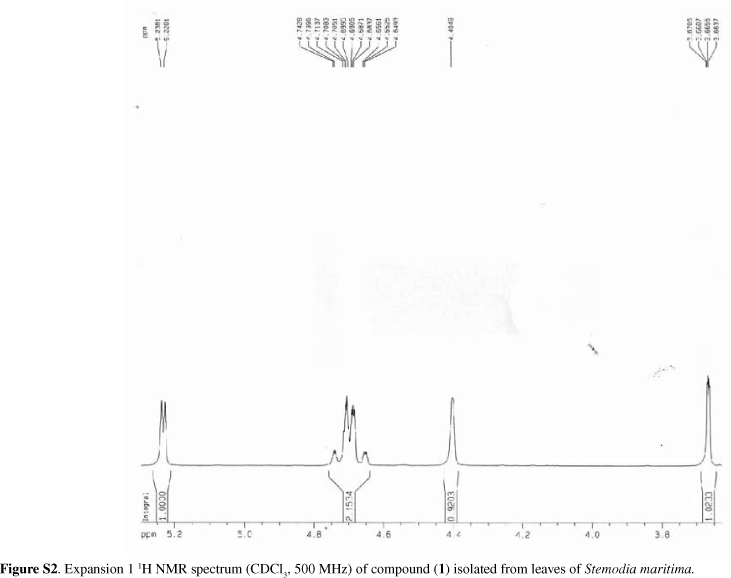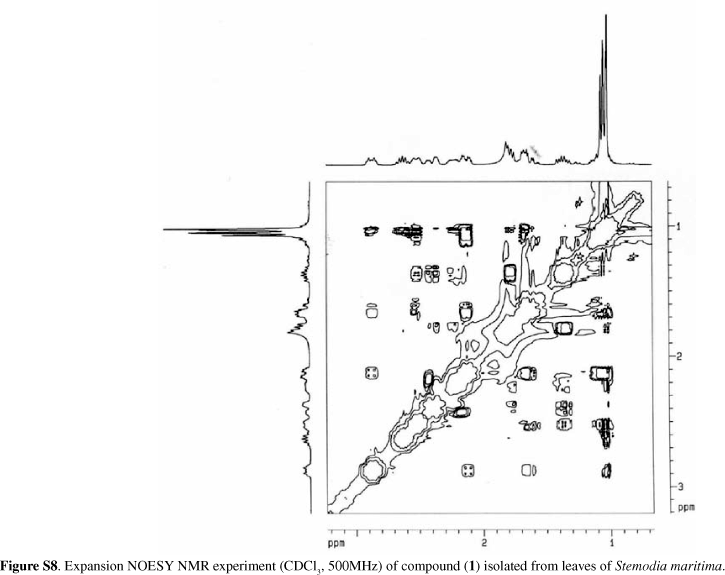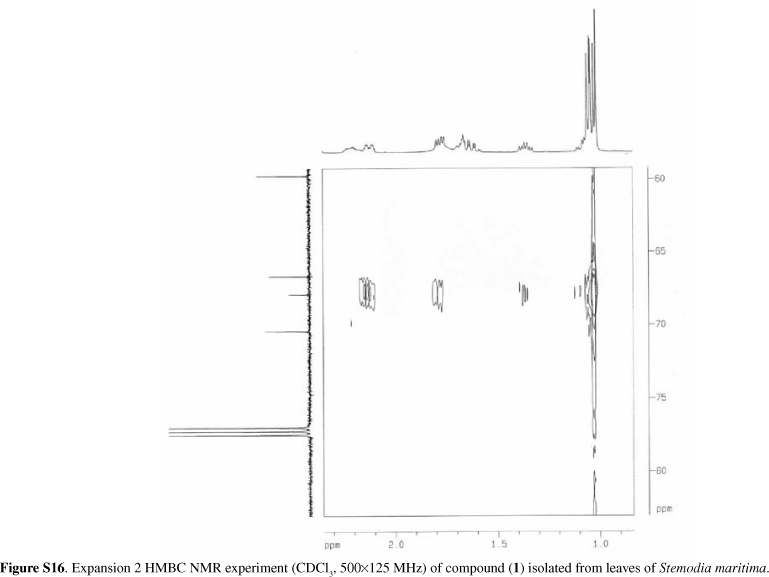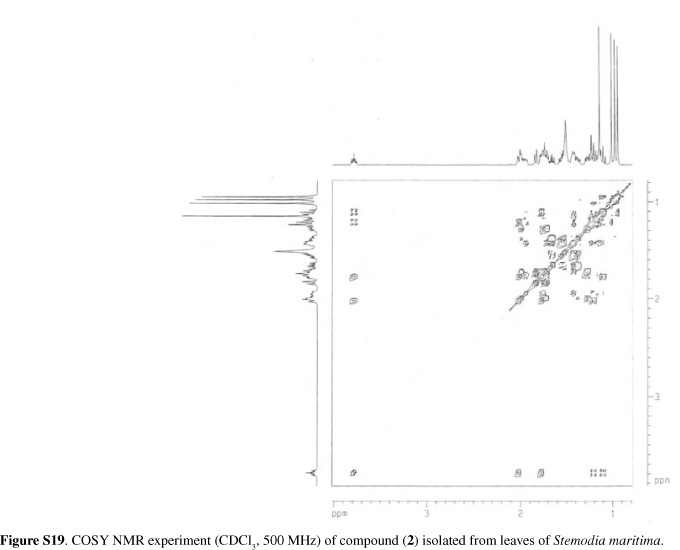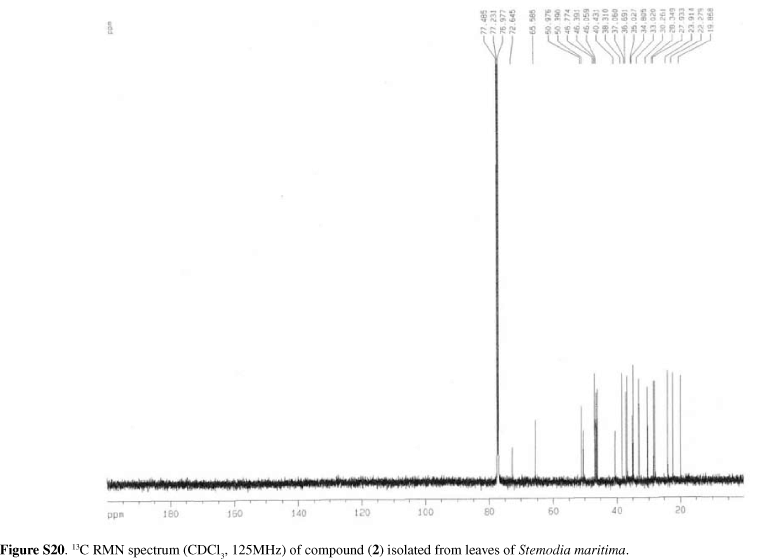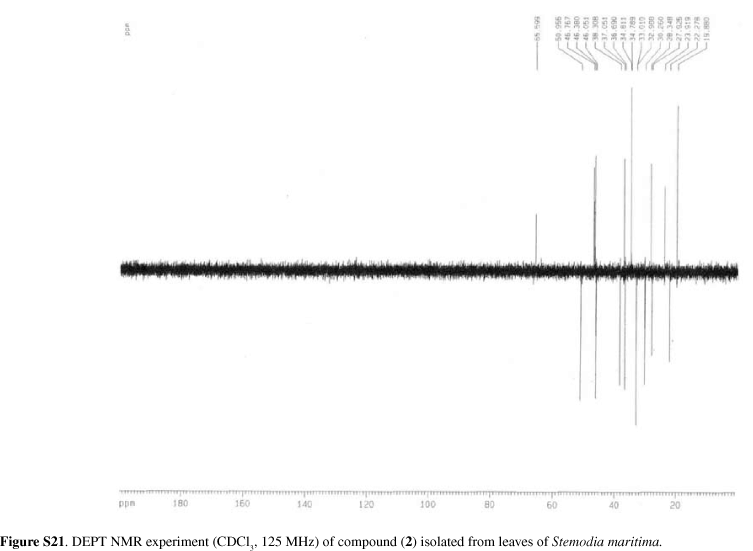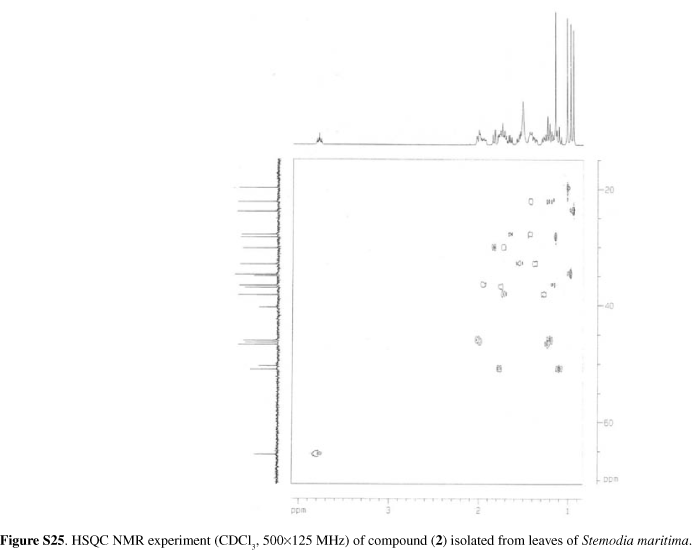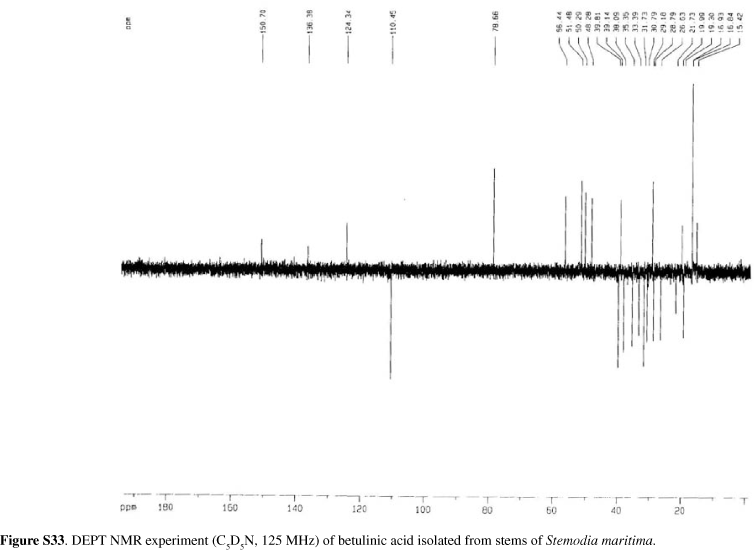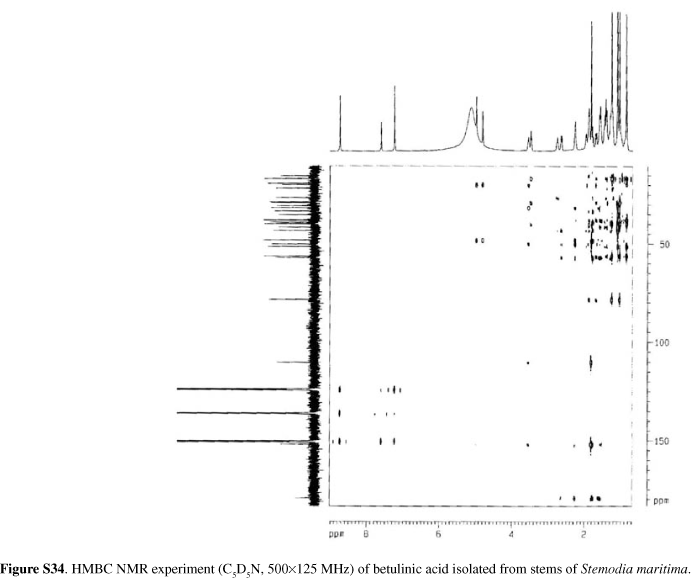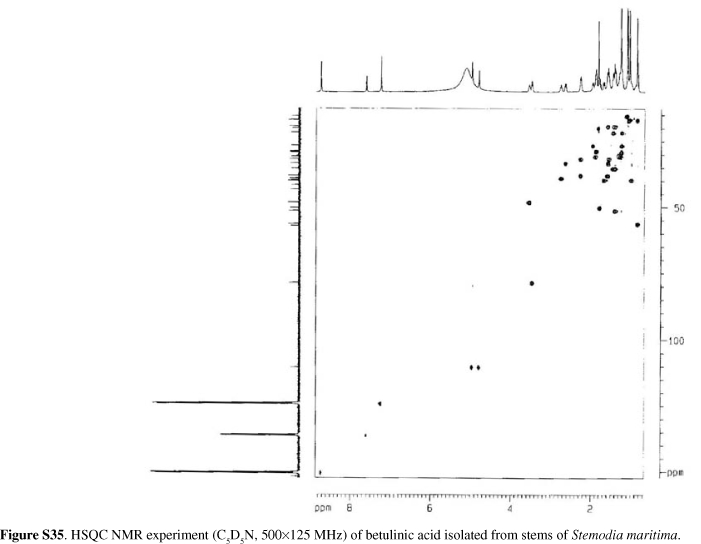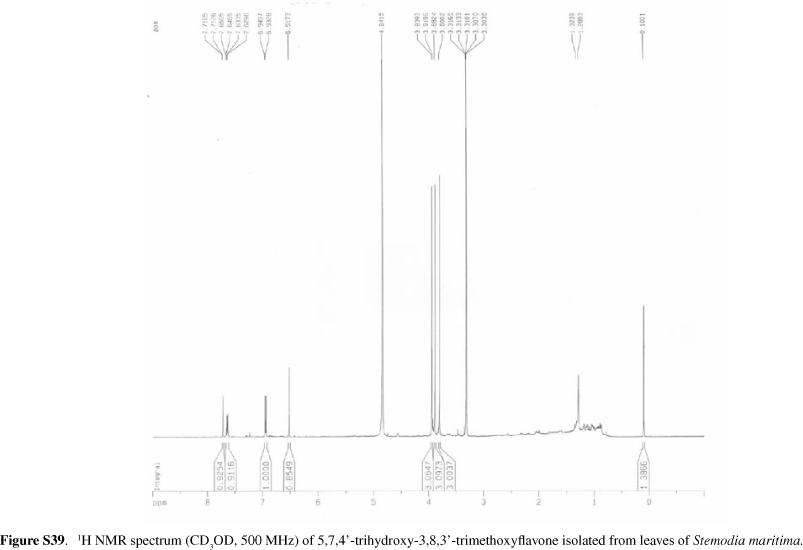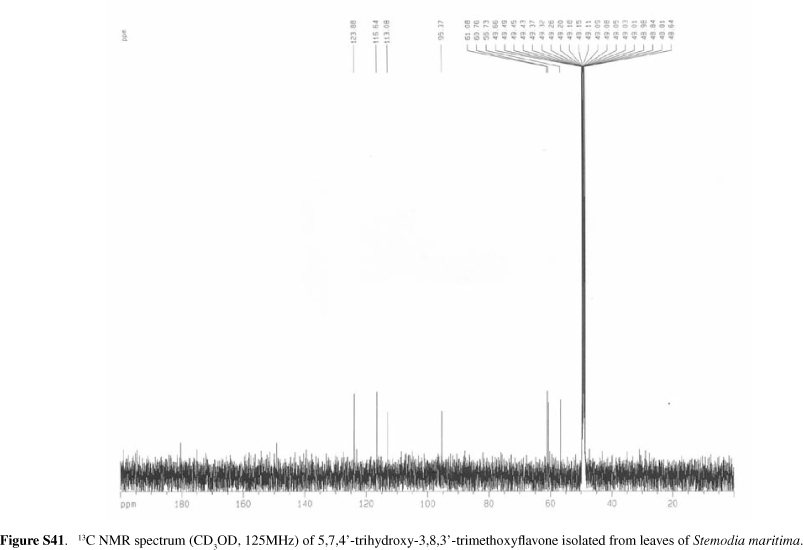Abstracts
A new diterpene, (5S*,8S*,9R*,10S*)-11β,12β-epoxy-9α-hydroxy-19(4→3) abeo-abieta-3,13-diene-19,18-olide, together with the known compounds stemodin, D-mannitol, betulinic acid, a mixture of 3β-O-β-D-glucopyranosyl-β-sitosterol and 3β-O-β-D-glucopyranosylstigmasterol and 5,7,4'-trihydroxy-3,8,3'-trimethoxyflavone were isolated from the leaves and stems of Stemodia maritima. Structural elucidation of all compounds was based on interpretation of spectral data, mainly NMR (1D and 2D) and MS, including comparison with values described in the literature.
Stemodia maritima; Scrophulariaceae; diterpenes; steroids; flavonoids
Um novo diterpeno, (5S*,8S*,9R*,10S*)-11β,12β-epoxi-9α-hidróxi-19(4→3) abeo-abieta-3,13-dieno-19,18-olideo, e as substâncias conhecidas estemodina, D-manitol, ácido betulínico, uma mistura de 3β-O-β-D-glicopiranosil-β-sitosterol e 3β-O-β-D-glicopiranosilestigmasterol, e 5,7,4'-triidróxi-3,8,3'-trimetoxiflavona, foram isolados das folhas e talos de Stemodia maritima. A elucidação estrutural de todas as substâncias baseou-se na interpretação de dados espectrais, principalmente RMN (1D e 2D) e espectrometria de massa (EM), envolvendo comparação com valores descritos na literatura.
SHORT REPORT
Diterpene and other constituents from Stemodia maritima (Scrophulariaceae)
Francisco E. A. RodriguesI; Jefferson Q. LimaI, II; Maria da Conceição F. de OliveiraI; Jackson N. VasconcelosI; Gilvandete M. P. SantiagoI, III; Jair MafezoliI; Raimundo Braz-FilhoIV; Angela M. C. ArriagaI, * * e-mail: angelamcarriaga@yahoo.com.br
ICurso de Pós-Graduação em Química, Departamento de Química Orgânica e Inorgânica, Universidade Federal do Ceará, CP 6036, 60451-970 Fortaleza-CE, Brazil
IICurso de Engenharia Ambiental, Instituto Federal do Ceará, Campus Juazeiro do Norte, 63040-000 Juazeiro do Norte-CE, Brazil
IIIDepartamento de Farmácia, Universidade Federal do Ceará, 60430-370 Fortaleza-CE, Brazil
IVCentro de Ciências e Tecnologias, Universidade Estadual do Norte Fluminense Darcy Ribeiro, 28013-603 Campos dos Goytacazes-RJ, Brazil
ABSTRACT
A new diterpene, (5S*,8S*,9R*,10S*)-11β,12β-epoxy-9α-hydroxy-19(4→3) abeo-abieta-3,13-diene-19,18-olide, together with the known compounds stemodin, D-mannitol, betulinic acid, a mixture of 3β-O-β-D-glucopyranosyl-β-sitosterol and 3β-O-β-D-glucopyranosylstigmasterol and 5,7,4'-trihydroxy-3,8,3'-trimethoxyflavone were isolated from the leaves and stems of Stemodia maritima. Structural elucidation of all compounds was based on interpretation of spectral data, mainly NMR (1D and 2D) and MS, including comparison with values described in the literature.
Keywords:Stemodia maritima, Scrophulariaceae, diterpenes, steroids, flavonoids
RESUMO
Um novo diterpeno, (5S*,8S*,9R*,10S*)-11β,12β-epoxi-9α-hidróxi-19(4→3) abeo-abieta-3,13-dieno-19,18-olideo, e as substâncias conhecidas estemodina, D-manitol, ácido betulínico, uma mistura de 3β-O-β-D-glicopiranosil-β-sitosterol e 3β-O-β-D-glicopiranosilestigmasterol, e 5,7,4'-triidróxi-3,8,3'-trimetoxiflavona, foram isolados das folhas e talos de Stemodia maritima. A elucidação estrutural de todas as substâncias baseou-se na interpretação de dados espectrais, principalmente RMN (1D e 2D) e espectrometria de massa (EM), envolvendo comparação com valores descritos na literatura.
Introduction
Stemodia Benth. is one of Scrophulariaceae genus and occurs in tropical and subtropical regions of the world.1 Although Stemodia comprises about 40 species, the chemical investigation of this genus is restricted to five species4 from which flavonoids,2,3 labdane diterpenes4,5 and diterpenes derivatives with a rare tetracyclic skeletal, named stemodane, were isolated. This later class of diterpenes seems to be chemomarkers of Stemodia.6
S. maritima Linn. is a very common shrub that widely grows in Northeast Region of Brazil, near the sea coast, where it is known as "melosa". It has been used to treat stomachache, dropsy and swelling by local population, although toxic symptoms was reported in cattle.7 Stemodane diterpenes, including glycosides derivatives, possessing antiviral and cytotoxic properties were isolated from this species.6,8-10 The chemical composition and larvicidal activity of its essential oil were recently reported.11
On the course of the phytochemical investigation of S. maritima from the Northeast Region of Brazil, herein we report the non-volatile composition of this species. A new diterpene, (5S*,8S*,9R*,10S*)-11β,12β-epoxy-9α-hydroxy-19(4→3) abeo-abieta-3,13-diene-19,18-olide (1), together with the known compounds stemodin (2) (Figure 1), D-mannitol, betulinic acid, a mixture of 3β-O-β-D-glucopyranosyl-β-sitosterol and 3β-O-β-D-glucopyranosylstigmasterol, and 5,7,4'-trihydroxy-3,8,3'-trimethoxyflavone were isolated from the leaves and stems of this plant. Structural elucidation of all compounds was based on the interpretation of spectral data, meanly NMR (1D and 2D) and MS, and comparison with literature data.
Results and Discussion
The molecular formula of compound 1 was established through HR-ESI-MS, which showed the quasi-molecular ion peak at m/z 331.1799 ([M+1]+, corresponding to the molecular formula C20H26O4 and indicating eight degrees of unsaturation. EIMS from 1 showed the molecular ion peak at m/z 330 (C20H26O4, 5%) and additional peaks at m/z 315 (C19H23O4, 7%) and m/z 287 [C17H19O4, 100%], attributed to fragments 1a and 1b, respectively (Figure 2). The presence of a hydroxyl absorption (νmax 3433 cm-1) and an α,β-unsatured-γ-lactone (νmax 1729 cm-1) was inferred from its IR spectrum.
The 1H NMR spectrum (Table 1) revealed the presence of an isopropyl group (δH 1.03, d, J 6.8 Hz, 3H-16; δH 1.05, d, J 6.8 Hz, 3H-17; δH 2.62, sep, J 6.8 Hz, H-15), a methyl group at δH 1.01 (3H, s, 3H-20) attached to quaternary carbon, two oxygenated methine hydrogens at δH 3.66 (dd, J 2.5 and 1.9 Hz, H-11) and δH 4.40 (brs, H-12), compatible with the presence of an epoxy ring, two deshielded hydrogen from a oxygenated methylene group at δH 4.72 (brdd, J 17.2 and 1.6 Hz, H-19α) and δH 4.68 (brdd, J 17.2 and 1.6 Hz, H-19β), and an olefinic hydrogen at δH 5.24 (brd, J 5.0 Hz, H-14).
Analysis of BB and DEPT 135° 13C NMR spectra (Table 1) revealed 20 lines, in accordance with the molecular formula C20H26O4. From these data it is possible to deduce the presence of the six non-protonated carbons: one carbonyl group (δC 173.9), three sp2 carbons, one oxygenated sp3 carbon and one non-oxygenated sp3 carbon. Additionally, it was observed six methine carbons, including two sp3 oxygenated at δC 66.6 and 59.7 and one sp2 at δC 121.8; five methylene carbons, one of them oxygenated at δC 70.4, and three methyl carbons.
The aforementioned data were coherent with a non aromatic abietane-type diterpene that displays an epoxy ring, a tertiary hydroxyl group, an α,β-unsaturated-γ-lactone system and two double bonds, having some similarities with the diterpene triptolide.12
The location of these functions in the abietane skeleton was deduced through additional HMBC analysis (Table 1), which revealed the following long-range correlations: the epoxy hydrogens at δH 3.66 (H-11) with C-13 (δC 140.1, 3J) and at δH 4.4 (H-12) with C-13 (δC 140.1, 2J) and C-14 (δC 121.8, 3J); the isopropyl hydrogen at δH 2.62 (H-15,) with C-13 (δC 140.1, 2J) and C-12 (δC 66.6, 3J); the olefin hydrogen at δH 5.24 with C-12 (δC 66.6, 3J), C-13 (δC 140.1, 2J) and C-15 (δC 28.6, 3J). The position of the hydroxyl group at C-9 was established based in the correlations of this oxymethine carbon (δC 67.9) with the hydrogen of the methyl group (3H-20, δH 1.01, 3J), which is generally present in abietane-type diterpenoids.13 Finally, the butenolide ring involving the carbons C-3, C-4, C-18 and C-19 was located by the correlations of the methylene hydrogens at δH 4.72 and 4.68 (2H-19) with C-4 (δC 162.0, 2J), C-3 (δC 125.3, 3J) and C-18 (δC 173.9, 3J).
The relative configuration of 1 (Figure 3) was assigned by the analysis of the 1H-1H-NOESY spectrum. The β-orientation of the epoxy function (11,12β-epoxide) was determined by the dipolar interactions of the hydrogen at δH 3.66 (H-11) with 2H-1 (δH 1.77 and 1.36). In addition, the methyl signal at δH 1.01 (3H-20) exhibited cross-peaks with the hydrogens at δH 2.86 (H-8), δH 2.20 (H-2β) and δH 1.62 (H-6β). The hydrogen at δH 2.51 (H-5) showed dipolar interaction with the hydrogens at δH 1.77 (H-1α), 1.67 (H-6α) and 1.07 (H-7α). Based on these correlations, the hydroxyl group at C-9 was established at α position (Figure 3). Therefore, all these data allowed to establish the structure of 1 as (5S*,8S*,9R*,10S*)-11β,12β-epoxy-9α-hydroxy-19(4→3) abeo-abieta-3,13-diene-19,18-olide.
Compound 2 was obtained as colorless crystal and its molecular formula C20H34O2 was deduced by EIMS ([M]+, m/z 306) and 1H and 13C NMR analysis. Its IR spectrum showed hydroxyl absorption at νmax 3311 cm-1. All spectral data were in accordance with the structure of the stemodin (2), a stemodane-type diterpene previously isolated from Stemodia species.6,8
Compound 2 was submitted to acetylation with pyridine and acetic anhydride (see Experimental section), yielding 2a8 (Figure 1). The 1D and 2D NMR spectral data of 2 and of its acetyl derivative (2a) were also used to complete 1H and 13C chemical shifts described in Table 2. Dipolar interactions observed from 1H-1H-NOESY analysis of 2 are summarized in Figure 3.
The other isolated compounds were identified on the basis of their spectral analysis and comparison with the literature data.
Experimental
General experimental procedures
Melting points were obtained from a Mettler FP82HT apparatus and are uncorrected. IR spectra were recorded using a Perkin Elmer 1000 FT-IR spectrophotometer. Optical rotations were measured on a Perkin Elmer 341 polarimeter. High resolution electrospray ionization mass spectra (ESI-MS/MS), in positive mode, was performed on a QTOF Micromass spectrometer (QqTOF, Micromass-UK). 1H and 13C NMR spectra were recorded on a Bruker Avance DRX-500 (500 MHz for 1H and 125 MHz for 13C); chemical shifts are given in ppm relative to residual CHCl3 (7.27 and 77.23 ppm). Silica Gel 60 (Merck, 230-400 mesh) was used for analytical TLC. Silica gel 60 (Merck, 60 F254, 0.2 mm) was used for column chromatography. All compounds were visualized on TLC by spraying with vanillin/perchloric acid/EtOH followed by heating.
Plant material
S. maritima was collected during the flowering stage in September 2006 along the Flexeiras Beach, Ceara Cost, Northeast of Brazil. The plant was identified by Dr. F. S. Cavalcanti and Prof. E. P. Nunes from the Herbário Prisco Bezerra (EAC), Universidade Federal do Ceará, Fortaleza, Brazil, where a voucher specimen (# 38483) is deposited.
Extraction and isolation
The fresh stems (200.0 g) of S. maritima were exhaustively extracted with ethanol, at room temperature, to obtain a crude material, composed by a precipitate, which was recrystalized from methanol to give D-mannitol14 (80.0 mg, 0.04%).
The aqueous extract obtained after the essential oil extraction (hydrodistillation) of the fresh stems of S. maritima was submitted to liquid-liquid partition with hexane/MeOH (3:7). The hexane fraction (340.0 g) was submitted to column chromatography on silica gel column, using a gradient solvent system of hexane and CH2Cl2. Chromatography of the subfraction hexane (380.0 mg) using hexane/EtOAc mixtures with increasing polarity yielded betulinic acid15 (8.5 mg, 0.0025%). Successive flash chromatography of CH2Cl2 subfraction (2.0 g) using 0-100% CH2Cl2/EtOAc provided a mixture of 3β-O-β-D-glucopyranosyl-β-sitosterol and 3β-O-β-D-glucopyranosylstigmasterol16 (8.2 mg, 0.0024%).
After extraction of the essential oils from the leaves of S. maritime by hydrodistillation, the aqueous extract was subjected to liquid-liquid partition with ethyl acetate. The organic fraction (4.0 g) was chromatographed over silica gel with CHCl3, EtOAc and MeOH to afford three subfractions F1-F3. Successive flash column chromatography of F1 (1.2 g), previously eluted from CHCl3, yielded 2 (45.3 mg, 1.13%) after elution with CHCl3/hexane 7:3. From these same column, fraction CHCl3/hexane 9:1 (180.0 mg) was also obtained and rechromatographed over silica gel using the same eluent system to afforded 5,7,4'-trihydroxy-3,8,3'-trimethoxyflavone17 (6.5 mg, 0.0019%) and 1 (15.6 mg, 0.39%).
(5S*,8S*,9R*,10S*)-11β,12β-epoxy-9α -hydroxy-19(4→3)abeo-abieta-3,13-diene-19,18-olide (1)
Crystalline Solid; mp 264.6-266.5 °C; IR (film, KBr) νmax/ cm-1: 3433, 2962, 2866, 1729, 1663, 1453, 1344, 1036; HREIMS, m/z 331.1799, required m/z 331.1909; [α]25D = -12.9° (c 1.0, CHCl3).
Stemodin ( 2 )
Crystalline Solid; mp 189.9-192.4 °C; IR (film, KBr) νmax/ cm-1: 3311, 2954, 1463,1367, 1217,1032; EIMS, m/z 306 (M+.), 291, 288, 273, 232, 217, 161, 94.
The structures of known compounds were established by 1D 1H and 13C ({1H} and DEPT) and 2D 1H-1H-COSY, HSQC and HMBC NMR spectral data (Table 2) and by comparison of their spectroscopy data with those reported in the literature.6
Acetylation of 2
To a solution of compound 2 (24.0 mg) in pyridine (0.5 mL) were added Ac2O (1.0 mL) and catalytic amount of DMAP. The mixture was stirred for 5 h at room temperature. Subsequent workup afforded a residue that was chromatographed using hexane/CHCl3 (1:1), hexane/CHCl3 (1:3) as eluent to yield compound 2a8 (12.0 mg, 50.0%) as a colorless solid.
Supplementary Information
Supplementary data are available free of charge at http://jbcs.sbq.org.br, as PDF file.
Acknowledgments
The authors acknowledge the financial support provided by Brazilian Agencies CNPq, CAPES, FUNCAP and PRONEX, and are grateful to Fundação de Amparo a Pesquisa do Estado do Rio de Janeiro (FAPERJ-RJ-Brazil) for the fellowship to visitant research and grants and to the Centro Nordestino de Aplicação e Uso da Ressonância Magnética Nuclear (CENAUREMN), Universidade Federal do Ceará (UFC), Fortaleza-CE, for the support to perform of the NMR (1D and 2D) spectra and to the Laboratório Thomson de Espectrometria de Massas, IQ-Unicamp, Campinas-SP, Brazil, for the high resolution mass spectra.
Received: June 24, 2009
Web Release Date: March 25, 2010
Supplementary Information
- 1. Chamy, M. C.; Piovano, M.; Garbarino, J. A.; Gambaro, V.; Phytochemistry 1991, 30, 1719.
- 2. Ramesh, P.; Nair, A. G. R.; Subramanian, S. S.; Curr. Sci. 1979, 48, 67.
- 3. Rodrigues, F. E. A.; MSc Dissertation, Universidade Federal do Ceará, Brazil, 2008.
- 4. Da Silva, W. M. B.; Assunção, J. C. da C.; Araújo, R. M.; Silveira, E. R.; Pessoa, O. D. L.; J. Braz. Chem. Soc 2009, 20, 37.
- 5. Da Silva, L. L. D.; Nascimento, M. S.; Cavalheiro, A. J.; Silveira, D. H. S.; Castro-Gamboa, I.; Furlan, M.; Bolzani, V. S.; J. Nat. Prod. 2008, 71, 1291.
- 6. Hufford, C. D.; Oguntimein, B. O.; Muhammad, I.; J. Nat. Prod. 1992, 55, 48.
- 7. Silva, D. M.; Correa, F. R.; Medeiros, R. M. T.; Oliveira, O. F.; Pesquisa Vet. Brasil. 2006, 26, 223.
- 8. Manchand, P. S.; White, J. D.; Wright, H.; Clardy, J.; J. Am. Chem. Soc. 1973, 95, 2705.
- 9. Martin, G. D. A.; Reynolds, W. F.; Reese, P. B.; Phytochemistry 2005, 66, 901.
- 10. Hufford, C. D.; Badria, F. A.; Abau-Karam, M.; Shier, W. T.; Rogers, R. D.; J. Nat. Prod. 1991, 54, 1543.
- 11. Arriaga, A. M. C.; Rodrigues, F. E. A.; Lemos, T. L. G.; de Oliveira, M. C. F.; Lima, J. Q.; Santiago, G. M. P.; Braz-Filho, R.; Mafezoli, J.; Nat. Prod. Commun. 2007, 2, 1237.
- 12. Ghisalberti, E. L.; Fitoterapia 1997, 68, 303.
- 13. Duan, H.; Kawazoe, K.; Bando, M.; Kido, M.; Takaishi, Y.; Phytochemistry 1997, 46, 535.
- 14. Pouchert, C. J.; Behnke, J.; The Aldrich Library of 13C and 1H FT NMR Spectra, Aldrich Chemical Company: Milwakee, 1993.
- 15. Kolak, U.; Turk. J. Chem. 2007, 31, 363.
- 16. Costa, H. N. R.; Santos, M. C.; Alcântara, A. F. C.; Silva, M. C.; França, R. C.; Piló-Veloso, D.; Quim. Nova 2008, 31, 744.
- 17. Roitman, J. N.; James, L. F.; Phytochemistry 1985, 24, 835.
Publication Dates
-
Publication in this collection
14 Oct 2011 -
Date of issue
2010
History
-
Received
24 June 2009



